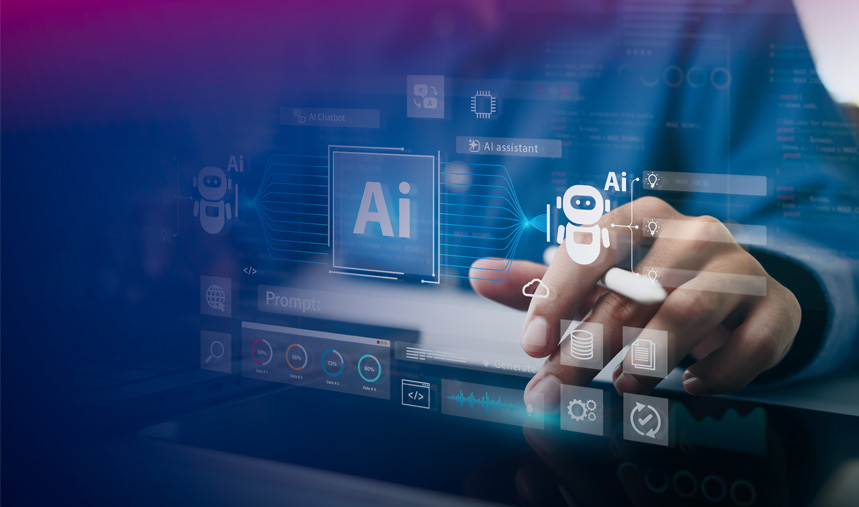What Is AI and ML, and How Are They Applied to Facial Recognition Technology?
Artificial intelligence (AI) and machine learning (ML) technologies have proved game-changers in many industries today. These technologies, designed to supersede human intervention in mundane tasks, possess the capability to manage mission-critical applications and enhance safeguarding measures. Let’s explore the various use cases of AI and ML, then understand their role in one of the most advanced forms of biometric security—facial recognition.
Artificial Intelligence: 3 Key Questions
1. What Is Artificial Intelligence (AI)?
AI is a technology that simulates human cognitive decision-making processes by using machines. From its ability to do things like recognize faces on your mobile lock screen or operate self-driving cars, AI has unleashed a new era of technology.
2. How Does AI Work?
AI uses intelligent algorithms on a set of unstructured data to analyze information patterns and correlate the information to provide outcomes. Being programmed to make cognitive decisions, AI augments various forms of automation by harnessing neural networks, machine learning, and deep learning to arrive at a decision.
3. Where Is AI Used?
Artificial Intelligence is an integral part of various applications and SaaS software. Some applications include image recognition, speech recognition, natural language generation, sentiment analysis, and chatbots.
And AI has several characteristics that look promising for the future:
- It can automate frequent, high-volume tasks by learning and discovering through data.
- It adds intelligence to products in automation, conversational platforms, smart machines, and bots.
- AI is also capable of self-learning through algorithms by finding structure and regularities.
- It can deep dive into data sets to help build complex products like fraud detection systems.
- It uses deep learning to ensure incredible accuracy by progressively analyzing inputs.
- Artificial Intelligence helps monetize data for businesses to stay ahead of the curve.
Machine Learning: 3 Key Questions
1. What Is Machine Learning (ML)?
Machine Learning is a subset of AI that leverages data and algorithms to mimic human learning. Using statistical methods, ML can train algorithms to classify, predict, and even provide insights into data mining projects.
2. How Does ML Work?
Machine learning takes the approach of letting computers learn to program themselves through experience. The first stage is to define the model. The second stage is to provide the model with training data, which is the information the machine learning model will be trained on. The more data, the better the program. In the next stage, the computer model trains itself to find patterns or make predictions. ML systems can be used to explain things that happened; to predict what will happen; classify information; generate content; or to make suggestions about what action to take.
3. Where Is ML Used?
- Automatic speech recognition using natural language processing to convert human speech into text. This is used in mobile devices to enable voice search.
- A touchpoint for customers on websites and apps by answering frequently asked questions about pricing, shipping, delivery, feedback, and returns.
- Virtual assistants and voice assistants to perform mundane tasks.
- In computer vision, to derive meaningful insights from images, videos, and visual inputs, especially in the field of radiology and self-driving cars.
- In marketing, to analyze consumer behaviour patterns, devise cross-selling strategies, and give recommendations to consumers on e-commerce websites.
Apart from thse common use cases, there is one application of ML that is particularly prevalent: facial recognition.
Facial Recognition: What Is It, and Why Is It So Important Now?
Facial recognition is one of the front-runner applications of AI. One of the advanced forms of biometric authentication, it can identify and verify a person instantaneously using facial features in an image or video from a database.
It is no surprise that in recent years, there have been increased investments in AI face detection technology. The facial recognition market was worth $5 billion in 2021 and is expected to nearly triple, reaching $12.67 billion by 2028. And with advancements in this technology comes new use cases and business models in advertising, healthcare, security, proctoring, airports, and more.
1. How Does Facial Recognition Work?
Face recognition uses AI algorithms and ML to detect human faces from the background. The algorithm typically searches for human eyes, followed by eyebrows, nose, mouth, nostrils, and iris. Once all the facial features are captured, additional validations using large datasets containing both positive and negative images confirm that it is a human face.
Facial recognition can be done using a range of different techniques, each with its own limitations.
|
Facial recognition techniques |
Approach |
Limitations |
|
Feature-based |
Relies on features such as eyes or a nose to detect a face. |
Outcomes vary based on noise and light. |
|
Appearance-based |
Uses statistical analysis and machine learning to match the characteristics of face images. |
Lacks rigor when determining reasons for errors. |
|
Knowledge-based |
Uses predefined rules to recognize a face. |
Requires effort to define the rules. |
|
Template-matching |
Compares images with previously stored face patterns or features, correlating the results to detect a face. |
Fails to address variations in scale, post, and shape. |
Where is Facial Recognition Used?
1. Access Control:
- Implemented in commercial and residential facilities, airports, and restricted resources.
- Enables secure entry, restricting access to authorized individuals.
2. Security and Surveillance:
- Utilized in warehouses, offices, and public spaces.
- Enhances surveillance, automatically alerts for targeted interventions.
3. Health and Safety:
- Monitors mask-wearing and temperature in public spaces.
- Integrated into health kiosks for real-time health checks.
4. Time and Attendance:
- Offers contactless clocking in and out for employees.
- Utilizes facial recognition for accurate and secure attendance tracking.
5. Fintech (eKYC):
- Digitizes KYC processes for financial institutions.
- Allows remote verification and access to services using facial recognition.
6. Smart Retail and Personalized Experiences:
- Recognizes VIP customers for personalized services.
- Enables smart advertising and cardless, contactless payments.
7. Law Enforcement:
- Aids in finding missing persons and human trafficking victims.
- Assists individuals unable to identify themselves, promoting public safety.
AI and ML: Endless Opportunities
Artificial intelligence and machine learning have applications across sectors like healthcare, education, and security. While these technologies promise innovation and improvement, ensuring the ethical use, privacy, and security of data is paramount.
Incorporating ethical considerations means upholding integrity through informed consent and transparent data usage, thus promoting responsible technology utilization. Adaptability is also key, requiring regular system updates and continuous learning to stay ahead of emerging threats and technological advancements.
Properly used, AI and ML technologies are powerful tools for innovation.




